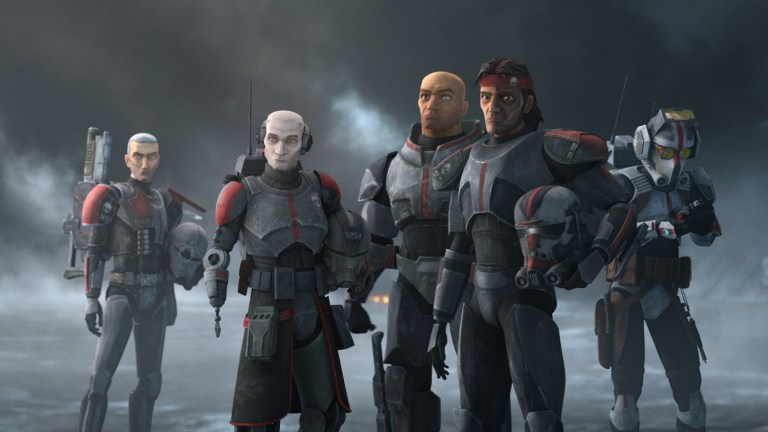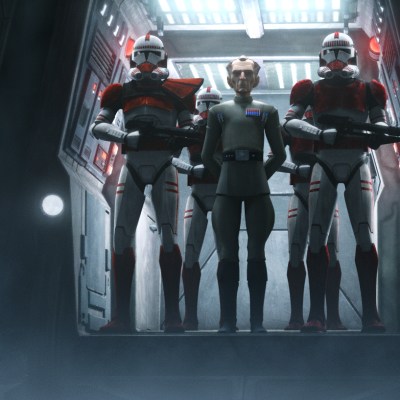Star Wars: The Bad Batch Episode 1 Review: Aftermath
Star Wars: The Bad Batch kicks off with plenty of action, with some exciting character moments along the way, but can the protagonists hold the audience's attention?

This Star Wars: The Bad Batch review contains spoilers.
The Bad Batch Episode 1
During the opening scene of The Bad Batch, the new animated series set during the rise of the Empire, the The Clone Wars logo burns away. At once blatant marketing and a promise of something new, the logo neatly explains what The Bad Batch is.
As Jennifer Corbett (producer and head writer) and Brad Rau (producer) said during a press junket ahead of the May 4 premiere, this show is a spiritual successor and also a direct sequel to The Clone Wars. The beginning of the new show draws from the epic scale of The Clone Wars‘ series finale (and the Star Wars Prequel Trilogy which it parallels). But while the action and heart are all there on paper, stock characters and a too-straightforward plot drag down the 70-minute premiere.
The five characters of the Bad Batch, lead by elite clone Hunter, never quite fit in. Like many other aspects of technology in Star Wars, cloning isn’t an exact science, and Clone Force 99 are “deviant” or “defective” depending on who’s talking, but they’re very good at their jobs of fighting on behalf of the Republic. But when the Republic transitions to the Empire, they’re immediately asked to start doing messier jobs, such as hunting down human rebels, whereas they’d usually fight droids. As you’d expect, the clones swap sides and, of course, end up having to fight their way out of their home base. A young girl clone named Omega helps them out, and the stage is set for the rest of the season, which will have at least 14 episodes.
Stream your Star Wars favorites right here!
Star Wars guru Dave Filoni is joined by Star Wars Resistance writer Jennifer Corbett on the creative side. Her pedigree in delivering stories for the Sequel-era animated show, and her experience in the U.S. Navy, make her an ideal guide for this war story. As military science fiction, The Bad Batch is serviceable, with the creative action and silly one-liners typical of The Clone Wars. The franchise’s approach to animation is always improving, which in this first long episode manifests mostly in impressive snow and a fun depth of field effect. The sharp corners of armor contrast nicely against soft, blurred lights in the out-of-focus backgrounds.
As far as plot goes, it’s pretty simple, leaving me to want to dig into some of the more weighty sections but not sure whether they’re actually statements. The Bad Batch see the other clones turn on the Jedi during Order 66, but for the same reason their other “defects” make them stronger, the inhibitor chips that should brainwash them according to the Emperor’s wishes don’t work. They choose to let the Jedi in their vicinity live. Future-Grand Moff Tarkin sees their rebelliousness as a good chance to prove the Clone Army is no longer effective. After all, conscripts would apparently be cheaper. But after the Batch uncover Tarkin’s true colors, they defect for good.
It’s cool to see this transition happening. What do clones become after the war? It’s a question hardcore Star Wars fans might leap to answer (they don’t all become stormtroopers, and not all stormtroopers are clones) but we haven’t seen it so directly on screen before. It’ll be nice if The Bad Batch addresses some of the practical questions around that.
Meanwhile, Tarkin’s clearly willing to shed civilian blood in a way the Jedi generals weren’t, replacing the clones bred for war with human volunteers. Like many other Star Wars stories set during the Prequel era, the Batch’s choice presents a moral decision with no right answers. The “good” choice here would be to maintain a status quo in which tens of thousands of people are born solely to fight wars with droids, which, while technically enemy soldiers, are also sapient. And while I can generally get lost in the military camaraderie fantasy here, the fact that other clones don’t like them makes what exactly the Bad Batch is fighting for even more muddled. Maybe this is about giving this squad a new cause they believe in outside of the definitely-bad Empire.
Or maybe the fact that it’s hard to tell the Republic’s policies from the Empire’s is the point. This is how the Republic fell after all: gradually.
The strongest character beats involve the characters learning to trust each other in new ways. Team leader Hunter’s superpowers are “enhanced senses,” although that isn’t really on display much. He begins to distrust team sniper Crosshair when Crosshair becomes over-eager to follow their grim mission by the book. Their arguments were most compelling before the inhibitor chip was introduced: while I know it fits with the lore, it defangs the story a little to have the main antagonist’s motivation be “he was brainwashed,” and I was a little unsure of how much the show was willing to either pin blame on him or absolve him of it. Either way, we haven’t seen the last of Crosshair.
The Bad Batch can’t even trust the Kaminoans, their creators and stewards of their beloved home. The one who shows this the best is team heavy Wrecker. His tendency to scream about blowing stuff up I generally find more annoying than funny, but toward the middle of the extended episode he adds pathos without getting away from this broad characterization. Wrecker isn’t programmed, he insists. He likes what he likes. His determination to hold on to a sense of himself as a person with free will feels like the real stakes of the show. It’s a section of the episode that quickly jumps back into goofy, fun action, but for a moment gets at something more serious and scary. Wrecker’s determination to hold on to his individuality shows exactly what Tarkin hates most about the clones. Ironically, in Tarkin’s estimation, he needs stormtroopers that can be even more tractable.
Unfortunately, the moments most important to this theme are undercut by repeating information the audience already knows. If you’ve watched The Clone Wars, you probably know about Fives’ discovery of the inhibitor chips and how Ahsoka helped Rex remove his. But moments like the one above sell the fact that the clones would be shocked to learn the truth about their new Empire.
The brand new member of the group is Omega, a young teenage clone introduced as both audience surrogate and mystery. (She’s also a particularly noticeable example of how the Empire is whitewashing the clones — those further from the Jango Fett template have lighter skin.) She’s a big fan of the Bad Batch because, like them, she’s an altered clone. It’s implied that she’s never really been able to make friends with other humans before, so it makes sense she’d latch on to the other unique clones in her orbit. Her fondness for them sometimes reads like a script for how much the audience is supposed to be fawning over the headliners, but the show never quite really shows the world from her perspective. Nevertheless, I think it’s overall a less jarring introduction than Ahsoka’s, who became a great character as she got more involved with the rest of the saga. It’s a “wait and see” with Omega as well.
I am a bit wary the series might be hurrying to repeat the sleight-of-hand pulled with Rey, presenting a character as both a point of view and a mystery at the same time. The first two episodes provided for review hint something bigger is going on with Omega, and how grounded that thing might be might determine whether it works. It’s become a bit tiring to use “who is this character?” as a jumping-off point rather than providing an answer in the first place and building from there.
As far as connecting to other Star Wars characters we do have answers for, The Bad Batch instantly announces that this will be a cameo-heavy episode, and…that’s okay? Now that they’re not being as coy about it as Rebels was, it’s a lot of fun to see Saw Gerrera and a young Kanan Jarrus. (Even if the latter cameo does instantly contradict the Kanan backstory comic released by Marvel a few years ago.)
When the Bad Batch were introduced in The Clone Wars I found them boring, their action figure-ready powers not any more compelling than the clones and Jedi we already had. They still seem a strange choice for headliners when characters like Ahsoka are operating at the same time. More so than The Clone Wars, The Bad Batch feels like a deep cut, a completionist tale that may struggle to hold fans. While comparisons between the avuncular Batch and Omega’s relationships with Din Djarin and Grogu are inevitable, this is no The Mandalorian in terms of either content or accessibility.



